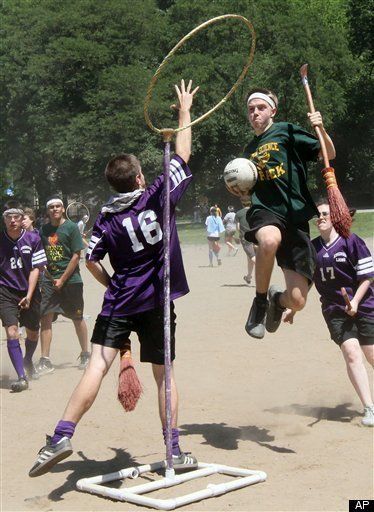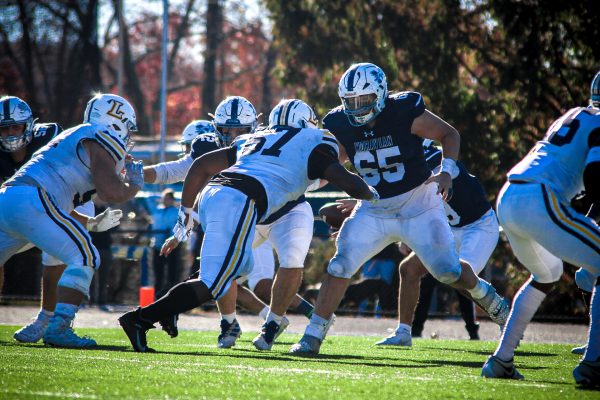How to Play Quidditch in the Muggle World
What game has three goal hoops, seven players on a team, five balls, and brooms? Quidditch, of course!
For the Muggles out there (or non-magic folk), quidditch is the sport played in the Harry Potter universe. So yes, it is fictional. However, real life students were not deterred by the fact that they can’t fly on broomsticks and decided to make their own Muggle version!
The USQ (United States Quidditch) is a non-profit organization that popped up in 2005 to govern and standardize the real life game of quidditch. They have taken the rules of the game in the fictional Harry Potter universe and translated them into realistic gameplay.
For anyone who hasn’t read the books or seen the movies, here’s a quick run down of the game:
In the wizarding world, quidditch has seven members on each team. They are made up of four different kinds of players: three chasers, two beaters, one keeper, and one seeker. There are four balls in use: one quaffle, two bludgers, and one golden snitch. The game is played on broomsticks, with players flying around a pitch set up much like a soccer or football field. The quaffle is the main ball in action, which the chasers throw between them.
The object of the game is to throw the quaffle in the opposing side’s goal hoops. Keepers (like goalies) are in charge of protecting their goal hoops from chasers. If a goal is scored with the quaffle, the scoring team receives ten points. Bludgers are enchanted balls that fly around the field looking to bash into players and disrupt their game. Beaters are in charge of directing the bludger away from their teammates.
Finally, the seeker is in charge of finding the golden snitch, a tiny golden ball that buzzes around the whole field, constantly evading capture. The seeker’s only objective is to catch the snitch. Once the snitch is caught, the game is over and the team who caught the snitch gains 150 points. Whichever team finishes the game with the most points wins. For a more entertaining and Muggle-friendly version of this explanation, you can watch Oliver Wood explain quidditch here.
For Muggle quidditch, it is important to retain all aspects of the fictional game but to do so without the magic.
The chasers and the quaffle stay basically the same. The quaffle is simply replaced with a volleyball. The chasers can throw, kick, or toss the ball between their players to score goals. The keeper remains the same as well, protecting the goal from the opposing side.
The interesting part is the substitution of the magical balls. The bludgers — the destroying balls that interrupt gameplay — are replaced with dodgeballs that the beaters throw at the opposing team. When a player is hit with a bludger (or dodgeball), they must drop any of the balls they are holding, return to their side of the field, and touch their goal post before returning to play.
Finally, the golden snitch, possibly one of the most important balls in the game, is replaced by an actual human. The person is released into the game 18 minutes into gameplay dressed in all yellow. The snitch must run to evade capture by both teams for as long as possible. They wear a velcro flag (much like in flag football) that the seekers much claim to end the game. The team that catches the snitch gains 30 more points. Once the game is finished, whichever team has the most points wins. And yes, all of this is played with players running around with a broom between their legs.

Real world quidditch has become popular across the U.S., specifically at colleges.
There are more than 100 college teams nationwide, and teams play in a tournament every year. Regional schools like Lafayette University, Lehigh University, Muhlenberg College, Drexel University, Chestnut Hill College, Lock Haven University, and Penn State University all have school-sponsored teams. Moravian even had one a few years ago, but it was discontinued after its players graduated.
The USQ is quite progressive in regards to the rules they created for the sport.
While many sports are divided between men and women, quidditch (both in fiction and in real life) is played with a combination of men and women on one team. The organization put in place a rule called Title 9 ¾ (a clear reference to both the Hogwarts Express, which stops at Platform 9 ¾ in the story, and the Title IX law on gender inclusivity). Title 9 ¾ states that a team may not have more than four people identifying as the same gender on the field at one time (five if the seeker later introduced also identifies as a specific gender). This rule is quite progressive because it calls into question the possibility of stacking genders on a team, as well as ensuring that more intergender games are played.
The USQ website states that “when all genders are able to compete equally on the pitch, they will learn to respect and value each other’s abilities regardless of gender identity,” hence teaching players both sportsmanship and human respect. (Sorry, Holyhead Harpies, all girl quidditch teams don’t fly here.)
While the sport may sound silly at first, it is an interesting way to get people who may not be considered “jocks” involved in a sport. While physically demanding, quidditch is a fun way for book nerds (myself being one of them) to join a sport and a community that is inclusive.
It’s not uncommon for non-athletes to be intimidated by joining a college level sports team if they have little or no experience. They are combated with a whole ecology of new people from student players to coaches to even the equipment room managers. They may be deterred from participating in these activities, which does not benefit anyone.
With the club team for quidditch, you know that you are joining a unique team that is simply playing for the love of its inspiration and, most importantly, for just plain fun.












